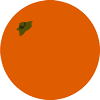Re- View #6:
The Small Way
Onjana Yawnghwe, Caitlin Press, 2018
Jami Macarty, Feature Editor & Leena Niemela, Social Media Manager
&
Bombing The Thinker
Darren C. Demaree, Backlash Press, 2018
Jami Macarty & Nicholas Hauck, Co-founders & Editors
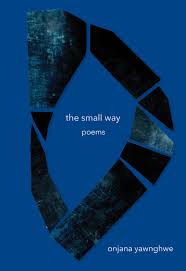
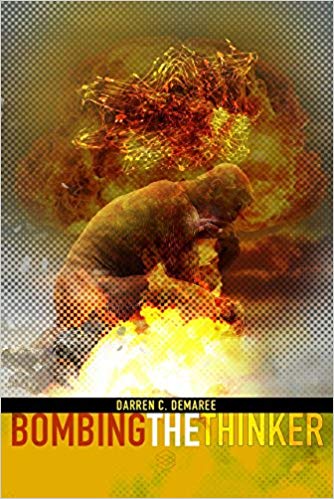
Jami: Welcome dear readers! As Views Feature editor, I wanted to try something new for Re- View #6. This time around, we’ll have two conversations about two books by two contributors. With co-founder and managing editor Nicholas Hauck, I’ll talk about Bombing The Thinker by Darren C. Demaree, and with editorial intern and social media manager, Leena Niemela, I’ll talk about The Small Way by Onjana Yawnghwe. Why the change? Why not! We’re constantly on the lookout for ways to expand the conversation about poetry. This is one of those ways—double the conversation and the books. It’s an experiment. Join us as we see how it goes.

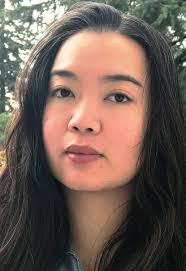
The Small Way is the second full-length collection of poetry by Canadian-Shan author Onjana Yawnghwe, who was born in Thailand, but grew up in British Columbia. From the book’s Acknowledgements: “Thank you to Hazel, who gave me permission to include her life experiences in this book. I will always be thankful for the love we shared, and the works we created together.” I start here because this statement lays important groundwork—the “permission” speaks to the shared creative expression of the relationship and love at the center of these poems. Within the Acknowledgements is also a claim: “This book is not a transition story. It is a story of relationship and what it means to love and lose someone.” I trust this distinction, for it makes explicit the author’s point of view as the one who loved and lost, and this transparency seems deeply respectful of the MtF former spouse. And, simultaneously, these statements raise related questions: How does this poet tell her story without also telling the story of her former spouse? And, perhaps more to the point, how does the former spouse’s transition impact the author’s story? The asking of these questions, the issues of permission and ownership are, as I see it, the book’s central tensions.
Leena: I agree. Though, at times, I found the poet also includes her assumptions about her beloved’s experience:
I saw the books on the shelf, read the titles.
Knew the plot and suspected its ending.
And you were still on the floor amidst the jumble of alphabets,
hands scrambling here and there, trying to recover forgotten words
(“Limbo,” 15).
Jami: I suppose technically this is an assumption-based observation. However, I see this more as the poet’s imagination at work, at the core of which is compassion, and an almost desperate attempt to be included and to understand. So, you know, we make up things, we assume—to sooth, to pretend we’re in control. Seems only human in these poems.
Leena: In “Rouseau’s Tiger” (21), drawing on the painting by Henri Rouseau,
who, according to the poem, “said it was nature that was his teacher/but he never saw in person the jungles” (21), the speaker links the unfolding experience of her spouse’s transition as both “teacher” and “jungle.” The poem ends with the image of the tiger “stoop[ed] in fear,/teeth bared, pupils large and stunned” while a storm rages.
Jami: Upheaval—emotional, hormonal, etc.—and the imagined and witnessed societal “storm” of judgment for the gender nonconforming is a concern of these poems. In the two-part prologue poem, “Chapbook (2004),” the reader is taken into a fabulist tale that “involves a hurricane” (8) and reckons with the perils of storytelling: the “risk of explanation” and “interpretation fails” (10). And, yet even in the presence of this awareness of “What exists between two people, I know little of” (“Another Cosmos,” 12) the poems and their author grapple for understanding, for “what we hold concretely” (“Another Cosmos,” 12). Did you notice the poems that literally reach for the stars for understanding?
These elements—parallel universes, light waves, and black holes—serve the poems in multiple ways.
Leena: Indeed, the cosmos is one of the central allusions in these poems. These elements—parallel universes, light waves, and black holes—serve the poems in multiple ways. For instance, take these lines from “The Big Bang” (14):
I swallowed it all with straining mouth, the doubts, the fears, the
unknown, questions of identity, sexuality, stars, satellites, black holes,
supernovas and all the rough cosmic debris.
The search to understand identity, sexuality, and by extension, gender, is cosmic debris; another element of inconceivable scale existing in the universe. Perhaps reaching for matter and energy is natural after an individual’s previous assumptions about her life are shattered. I was drawn to the many references to the bending of light pointing to unseen truths: “We know these things/exist because light bends towards and becomes curved” (“Another Cosmos,” 12). Also, the connection these poems make to light and the soul, and in particular to the lightness of a being living their truth:
A light filters from
your skin, a brightness settles in your eyes.
Perhaps it is a kind of happiness
that I have never seen there.
(“We Realize, and Realize Too Late,” 62)
The speaker’s knowing comes not from understanding the experience of another, but from observation and from love and loss. Love, too, becomes an element of “cosmic debris” in these poems:
We may be just a blinking star,
dead millions of years ago.
But the light, the light. Still it shines.
(“The Pale Blue,” 96)
Everything the poet/speaker thought has been turned on its head. The poems arise out of reckoning with the accompanying uncertainty.
Jami: The way you’re speaking about observation makes me wonder if, for you, the poems exist only as observance. For me this is not the case. I find experience here, deeply responsive, and soul-searching. Everything the poet/speaker thought has been turned on its head. The poems arise out of reckoning with the accompanying uncertainty. So, even as the poems look to the stars they also seek visceral understanding. In the poem “A Question of Bodies” (13), the speaker of the poem seems to come to some limited understanding:
This is the body I was born and live
with,...
Your body is not your own.
In “The Big Bang” (14), the letting go of “before” this understanding requires:
We were each other’s shadow, each taking turns in the moonlight
In “Catalogue” (17), a heightened, new focus of attention on bodies—color of skin, shape of features, morphology, gender:
This is to say I have never questioned my body
the way you have questioned yours.
Also, within that focus of attention is the difference of experience, of otherness:
We all wear our skins differently...
What you exactly feel I cannot know.
Then, in “Here to Answer Questions” (18), the poet seems to realize that “the need to explain what ‘trans’ means” is a “beginning” and only seems to beget more and bigger questions:
The self, I don’t know what that is.
And how do we know others is another question.
Leena: The speaker tells us “We take care of the body first” (“To Be Gracious is the Only Thing,” 29); that when faced with “feelings I can’t name/if they are feelings at all,” we have no recourse but to tend to the certainty of physical wounds, blood and bone. And yet, as you say, Jami, the poems reveal how, even in the certainty of our own wounds, we still cannot know another’s with the same certainty. It seems the poems reach for pin pricks of certainty that ultimately unravel upon further investigation. Along with these questions is the poet’s acknowledgement that physicality fails to express the soul, or rather that the soul persists beyond physical constraints. In “Theory of Relativity,” (35) the mirror becomes symbol for this apparent shortfall:
how it betrays, how it amplifies dissonance
between assigned gender and gender of the soul.
Jami: About mid-way through the 96-page collection, I became aware of the poems’ various forms. Perhaps that was my reader’s mind taking a break from the intensity of subject matter. The collection reads like a memoir, a memoir in poem-form. The poems themselves are mostly a single page long; all are left justified and columnar. Most of the poems are broken into strophes; the lines are medium length and line breaks are made via the sentence, predominantly. For poems that seem so connected to the concept of binary, I’m surprised there are so few couplets within them. Instead, the poems seem to depend on the tercet. That makes sense as a third way, a third thing is being revealed for the couple within the poems.
The content of these poems works to reveal the failure of binaries. The straightforward lines, interrupted periodically by unexpected syntax, highlights uncertainties inherent in the nonbinary.
Leena: I like your reading of form. Like you, I think the tercet speaks beautifully to the position of the speaker as one who navigates a new understanding, with old language and form, that is “pre-transition.” The content of these poems works to reveal the failure of binaries. The straightforward lines, interrupted periodically by unexpected syntax, highlights uncertainties inherent in the nonbinary. These are not great upheavals in language though, they are small infinitesimal shifts:
We immersed ourselves in such darkness,
see light bend toward it.
(“And We Kneel Before Heaven,” 58)
How many ways can a line be read when we investigate closely? “Under a microscope, lines are rarely straight.” (“Chapbook (2004),” 8), the poet writes. “Check Boxes,” (27) stretches and disrupts syntax in the lines “No use in hanging on/but unclasp and open,” while “Living Together,” (52) shifts tone of voice and loosens to a final “la dee la du wop du wop.” Even the shape of “Anteroom of Memory” (44) on the page, seems to unravel before us. These poems are like “light bend[ing] toward” some, as-yet, unseen language or line. I appreciate how these gestures jar reader expectations, and how these gestures mirror how content and form play out the tension of the subject matter.
As we might expect, these poems depend on the narrative, blending in the lyric, to write deeply private poems of the ethics of caring and of profound letting go.
Jami: As we might expect, these poems depend on the narrative, blending in the lyric, to write deeply private poems of the ethics of caring and of profound letting go. For me, within the shared intimacy of the poems is the poet’s generosity. Also alive is trust. The trust of the reader seems particularly special in these poems; for it is the reader who is witness to and present for the catalogue of firsts as this story unfolds:
At first I will be beside you, then behind,
As you take your first steps as a woman.
(“A Step Behind,” 23)
The poems seem to move back and forth between levels of knowing what must happen and the pain of inevitability, often simultaneously:
I need to learn
to relinquish this yearning
(“We Watch the Dark,” 25)
All the while striving: “To Be Gracious Is the Only Thing,” (29) while making discoveries about:
What I thought was sure I was sure of,
matters of men and women and
gender identity and sexual attraction.
(“Now the Wind Shakes Us,” 26)
and contending with the enormity of change, containing both as-yet unfathomed uncertainty and the glimmer of possibility:
So many ways
(to think of
oneself now),
(“Check Boxes,” 27)
Then, it seems in rebound from that glimmer, uncertainty and questions take another turn:
I don’t know where my husband went
Or if I’m allowed to think of “him”—
(“What If Beginnings,” 30)
Such profound questions as:
Who am I?
(“What If Beginnings,” 30)
and,
How does a woman.
(“Woman,” 41)
Womanhood is under the microscope here and the fissures form the stage for our speaker’s heartbreak.
Leena: Womanhood is under the microscope here and the fissures form the stage for our speaker’s heartbreak. In observing her beloved’s transition to woman, she views her own femininity a failed performance:
I’m actually a failure
at femininity, always feeling out of place
among dresses and skirts
(“Woman,” 39)
and
I ask myself sometimes if my chosen
childlessness is my failure of womanhood.
(“Of Tired Bodies,” 31)
In watching her beloved step into womanhood, how she reads the physical performance, makeup, fashion and the cultural trappings of what a woman is, the speaker’s own “anxieties of womanhood” (“Not Superficial,” 34) are revealed. In “Woman” (36-42) the speaker unravels what it is to be a woman, telling us:
There is no correct
way to be a woman.
Only the vague unease perpetuated by
movies and magazines, glossy with lack. (42)
I often longed for our speaker’s freedom from her sense of failure. She is a speaker lost amid her own grief, and in her observance of her beloved’s gradual but inevitable departure, I yearned for her to grant herself the same permission to:
Step into the skin you have always known.
Step into the skin you’ve always known.
You are woman, and have always been. (42)
If not permission to be free of a sense of failure within the relationship, the poems seem to grant permission to remember the love as it was before the memories became stuck “in some sort of purgatory” (“Anteroom of Memory,” 44). The poems seem also to grant permission to the poet as the “one of us, one of us needs to remember” (“Postcards,” 65).
Jami: In the poem, “The Cinematheque” (85), the speaker wants:
to take you to the Rodin Museum
and show you the tiny sculptures of
Camille Claudel who, unlike her lover,
sculpted what people felt on the inside.
Here’s a point where Yawnghwe’s collection intersects with Demaree’s, Bombing The Thinker. The bombing of Auguste Rodin’s most famous sculpture, The Thinker, at Cleveland Museum of Art in 1970 is the subject of Demaree’s collection. Yawnghwe aligns herself, not with Rodin, but with Camille Claudel, Rodin’s lover. So, we might deduce Yawnghwe, in the end, wants not to be a thinking man, wants not to have made a monument to thought, but wants to have made a monument to love—from the inside out. These love poems, that insist they are not about “transition” are still very much of our contemporary moment, a place where it’s possible to “Google how to recover from heartbreak” (“How to Recover from Heartbreak,” 81). The poems search and research, they record and go on the record to “recover from heartbreak.” But, most of all, what these poems want, what this poet wants:
I think I want you to understand something
of myself and of how much I loved you.
(“The Pale Blue,” 93).
Now, more about our other book...


Bombing The Thinker is US poet Darren C. Demaree’s ninth poetry collection. In this collection, Demaree converses and reasons with Williams Carlos Williams’
It is difficult
to get the news from poems
yet men die miserably every day
for lack
of what is found there.
(“Asphodel, That Greeny Flower” [excerpt])
The “news” we get from Demaree’s poems is that of the March 24, 1970 bombing of Auguste Rodin’s (French, 1840-1917) bronze sculpture The Thinker (1880-81), which sits in front of Cleveland Museum of Art. According to the Museum’s website, the sculpture is one of twenty-five 72-inch versions of Rodin's The Thinker. Of these, fewer than ten were cast and patinated during his lifetime. This particular sculpture is one of the last Rodin-supervised casts; it was acquired in 1916, and given (by Ralph King) to the Museum in early 1917. Here it is, after the bombing, legless.
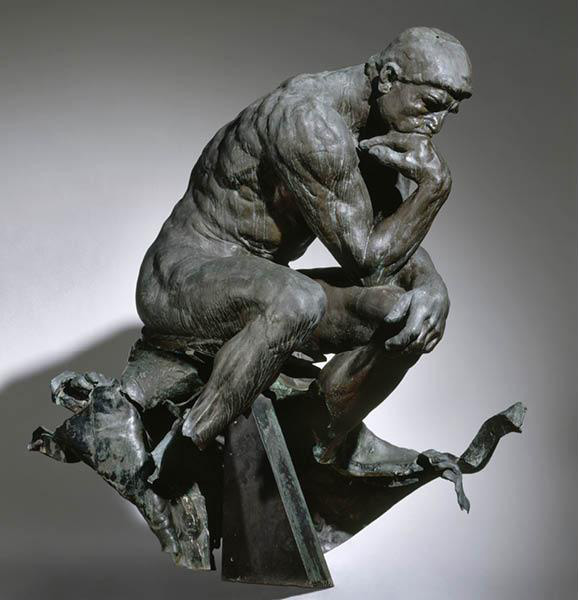
Within the book is a series of twenty-six poems titled, “A Damaged Thinker”; in these poems, The Thinker speaks directly to the “politico cowards” (“A Letter To Auguste Rodin Asking About His Other Casts Of The Thinker,” 31) that blew off his legs:
I have
a heart that was never
proven real, but that
does not mean I deserved
to become your shrapnel
(“A Damaged Thinker #3,” 17).
In Demaree’s imagination, The Thinker, is not only contemplative, he is smart, funny, and militant.
Accompanying each of this series’ poems is a numerical designation, e.g. #2, #3, #12, #13, etc.; though the numbers are presented in ascending order, they are not sequential. These numerical gaps seem to allow for time to think before The Thinker speaks again:
Mostly, I think
about fire rising to my face
(“A Damaged Thinker #12,” 27).
In Demaree’s imagination, The Thinker, is not only contemplative, he his smart, funny, and militant:
Confident
in the danger
of my own thoughts,
I am waiting, here
because the action
here, still comes to me
& I am fucking ready
(“A Damaged Thinker #18,” 45).
Nick: The non-sequentially numbered “A Damaged Thinker” poems remind me of the gaps in artistic creation, too: the other casts of the sculpture dispersed around the world, the now legless version in Cleveland. I think there’s something being said here about process and against wholeness. I mean, aside from being a super interesting subject for a book of poetry, The Thinker raises questions about original and copy, authorship and conservation. After the bombing, the decision was made “not to heal him./He will remain un-alive” (“A Letter to August Rodin, Explaining the Bombing of The Thinker,” 38). Sherman Lee, who was the museum director at the time of the bombing, had a choice to make: replace, repair, or embrace. Demaree complements Lee’s choice and imagines him saying:
I would
cradle the man,
as he would cradle
me, if you people
would allow such
time to elapse
before we decided
how to treat
a sculpture
that has gone to war
to never, ever return
(“Finishing A Sherman Lee Quote,” 61-62).
Jami: The bombing of The Thinker has symbolic implications, too. This was an attack on freedom and knowledge, those ideals, and on reason itself:
The Thinker’s body
is slumped in thought
& if they had one real radical
in their group they would
have taken that sad man’s
head off, I mean, right?
(“Blown Up By Radical Protestors,” 23-24)
Nick: Right! A confused attack whose intention was retroactively thwarted by the resilience of those ideals, and by:
the gravitas
of an explosives victim willing
to be covered in oil. That
motherfucker was thick
with purpose
(“It Was Imperative To Remove The Oil,” 25).
I appreciate the moments when these poems refuse sentimentality. Matter-of-factness seems to take the place of mourning and what-ifs, since:
we don’t
need to know what
would happen if
the bomb had been
as flawed as the reason
(“A Unique And Haunting Beauty,” 13).
Jami: The Thinker, of course, has something to say about the fact that no one was ever arrested for the attack:
cruelty of time without
the punishment
of my assaulters. I want
them named, with Rodin,
as the men that made me
something to be seen.
(“A Damaged Thinker #, 24” 49)
One of the strengths of the book is the way The Thinker contemplates what could be considered trivial relative to the attack/the attackers.
Nick: For me, one of the strengths of the book is the way The Thinker contemplates what could be considered trivial relative to the attack/the attackers:
you must learn
to let shit roll down
your back...
sometimes, without
any wind, all I can do
is think about the bird shit
& wonder about my hair.
(“A Damaged Thinker #12,” 27)
That last line is so wonderful! It’s as if the patrons of art are more upset than The Thinker, or that he, at least has come to terms with what happened. The last two lines from “A Damaged Thinker #24” add a twist to this: Cleveland’s version of The Thinker is worth seeing because of Rodin and the bombers. Here, the patrons attracted to the destruction become the true face of the grotesque.
Jami: For me, a strength of the poems are their layers of shifting meanings and intellectual positions. After the bombing, the bombers are equated with Rodin as makers of The Thinker. That expands the reasons The Thinker wants the bombers caught. The Thinker wants to meet his other “makers.” That those responsible for the assault were never caught, adds to the humiliation, the injustice, and makes the attack worse:
Most people
didn’t care
that a statue
was blown up
& off the pedestal
& the reason why
mattered
even less. Cleveland
(“No One Was Ever Arrested,” 51)
Nick: The disregard for the act and the reasons behind it point to a general cultural apathy. Also concerning is the way tragedy—here cultural destruction—is collectively appropriated after the fact:
but once
the outrage finished
munching on
the tongue
of the vocal few,
I think we loved
him more
for his survival
& how he took
that shot like we
imagine men can.
He was art
before, but now
he’s special
to all of us.
(“An Eye-Catching Memorial Of Mindless Violence,” 35-36)
Art becomes monument, which for me is getting uncomfortably close to kitsch, and we lose sight of what art is.
At the center of these evaluative statements is the great misunderstanding of what art, at its core, is—a freedom of expression that protests destruction.
Jami: The apparent indifference of Cleveland’s citizens points perhaps to greater society’s indifference to art and art’s intangible value to it. This also reveals the way art and artists are among the collateral damage of politics and protest. At the center of these evaluative statements is the great misunderstanding of what art, at its core, is—a freedom of expression that protests destruction. Namely, art protests the destruction of war. The bombing pitted art against protest as if they’re different. Those who:
dared to change
the world with explosives,
which is a common dare,
(“A Direct Contemplation Of Hell,” 139),
all they accomplished was to create another maimed veteran of war:
carry him
like we always promise
veterans
we will carry
them
(“It’s More Than Just A Work Of Art,” 148)
Nick: The second poem in the collection, “1970,” alludes to the protest culture of the 60s when “there were so many hearts/& so little clarity” (“1970,” 11). The Thinker is one of the victims of that confused mash-up of energy forcing “revolution’s river/straight through art’s bend.” (“1970,” 11). The distinction between direct, stubborn revolutionary action as protest, and curved, nuanced artistic expression is still significant today.
Jami: The bombers, their protest...
They wanted art
to mean less
than human life...
They never understood
a single part of what
they were trying to do.
It was a rehearsal
of a doomed play.
The art, the money
& even the people
were always intertwined
& the war that made them
lose the feeling of all of that
took away the need
to punish their work.
(“Free From Arrest,” 55-56)
Uggh! That poem causes my stomach to pit. I feel an acidy mix of despair, fury, and impotency. Then I recover. Art, thinking about art, brings me to my senses. Art is always more than a work of art. I believe that and I believe art’s worth fighting for, for what are we fighting for if not freedom—to be who we are, say what we think?:
This was Rodin’s goal,
to show a man sinking
into torrid thought, bit
by the idea that he is
playing a game without
knowing all the rules
(“A Monument Now Reflects The Acts Of Insane Men,” 69)
The Thinker, was always “a monument” that “reflects the acts of insane men,” and now it reflects the acts of other, contemporary “insane men”—the bombers. We could even include Demaree’s poems—as “monument.” Is he one of the “insane men”? To what degree is he implicated?
Nick: I’m suspicious of the trope of the crazy artist. I think Demaree’s poems participate in the “monument” of The Thinker, but not in the same way the bombers do. Maybe they’re all “insane,” but the point of their work is very different.
Jami: Right, Demaree suggests not all art is created equal. Some art can withstand fire more than others. The Thinker, originally titled The Poet:
If he had stayed
simply The Poet
that fire would
have ruined him.
(“Originally Named The Poet,” 66)
Made of fire and metal, The Thinker has not been destroyed, as paper would have been by the fire, but has been reborn or reified.
Nick: Yes, and there’s this from “1970”:
If it had been a painting,
they would have dragged
a razor’s edge through it,
but since it was a man,
undeterred by bombs elsewhere
they scrawled a message
on the base of the statue
& erased it, almost, with fire.
(“1970,” 11-12)
This makes me think of protest artist Banksy’s latest stunt. Immediately after being auctioned off for £1m, his print was automatically shredded. Is there something about sculpture in general and The Thinker in particular that is more resilient than other forms of art? Maybe the way we interact with its materiality contributes to this sense of indestructibility; The Poet would have burned, but The Thinker was only “almost erased.”
Jami: The Thinker, by virtue of the fact that it wasn’t destroyed, seems to be resilient. That’s about the particular sculpture and its material. Also, is seems to be about “thinking”—that thought is indestructible, and about artistic expression—also indestructible. It comes back to art, the artistic endeavor, the powerful meaning of that gesture. Afterall this is a book of poetry!
because art is always pulling
close to other art, creating a home
undefeatable by simple dynamite
(“There Was Still A Pedestal,” 82)
I want to say a bit about more about art and beauty. There’s another series of poems in the collection that seem to instruct the reader on how to have a relationship with art. To reveal that relationship (and for fun!), I’ve worked their titles into a sentence: “A Unique And Haunting Beauty” is “Almost The Point Of Art”; whether the “Acceptance Of Art” or the “An Avoidance Of Art” or “A Cold And Lonely Piece Of Art,” “It’s More Than Just A Work Of Art.”
Upending assumptions and surprising us to think otherwise; that’s what art does.
Nick: Nice work! That “more,” it seems, is what makes art art. There’s always something supplemental. The Thinker:
classic, but contemporarily
flawed is almost perfect
in his destruction
of what we expect
from the best of our art
(“Almost The Point Of Art,” 19-20).
Upending assumptions and surprising us to think otherwise; that’s what art does. That’s what these poems do!
Jami: Human’s relationship to art isn’t formulaic, and yet we can’t seem to resist formulating opinions, reviews, valuations, etc. All the while the relationship is unquantifiable and impossible to fully articulate. It has something to do with:
what it means
about art
& cowards,
what it means
to survive,
damaged
& un-repaired
(“Poem #164 About The Thinker Bombing Makes Me Laugh,” 115)
Nick: The last poem speaks to the creative drive to endure,
We create
multiple salvations
with every piece
of humanity
we re-create
(“Any Night (Part Of The World),” 151).
This poem plays with multiplicity and fragmentation in the same way I feel the whole collection does. I appreciate how the last two lines, “it is fullness/& the time for more” in this poem consider art complete and open at the same time.
Jami: There’s so much to say about this book, and I admire its saying, its thinking. As a final word, I’ll say a bit about what I notice in the forms and choices within the poems. These are left justified, columnar poems, composed of short, double-spaced lines. I feel Demaree paid considerable attention to the lines and line breaks. Most lines are no more than nine syllables; that choice builds tension and rhythm within each poem and from poem to poem. The entire book is ekphrastic; within the book there are a number of series of poems. We’ve talked about some of them. One we haven’t yet mentioned is the series of epistles. That artistic choice allows for intimacy and seems to me particularly powerful. For these letters, composed by The Thinker, give art its voice. That, ultimately, is what art is—a giving of voice to fragmented experience:
Some day all of these
fragments will make us
both feel quite whole.
(“Looking For Intimacy In The Never Was,” 126)
